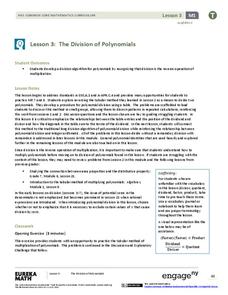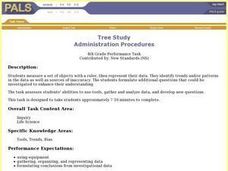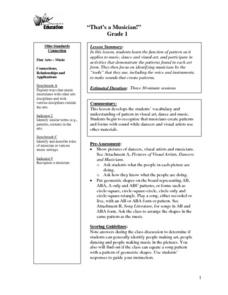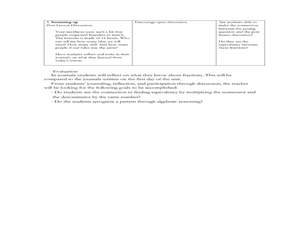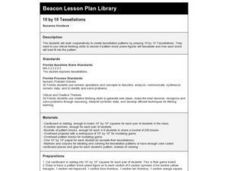EngageNY
The Division of Polynomials
Build a true understanding of division of polynomials. Learners use their knowledge of multiplying polynomials to create an algorithm to divide polynomials. The area model of multiplication becomes the reverse tabular method of division.
Inside Mathematics
Squares and Circles
It's all about lines when going around. Pupils graph the relationship between the length of a side of a square and its perimeter. Class members explain the origin in context of the side length and perimeter. They compare the graph to the...
California Polytechnic State University
Australian Geography Unit
At the heart of this resource is a beautifully detailed PowerPoint presentation (provided in PDF form) on the overall physical geography of Australia, basic facts about the country, Aboriginal history, and Australia culture and lifestyle.
Missouri Department of Elementary
The Successful Student: Just Checking
The final lesson in a skill-based series focuses on setting goals and making checklists. Class members discuss what it means to set realistic goals and practice making lists to manage their time effectively.
Missouri Department of Elementary
Are You Balanced?
Balance scales create a strong visual of how an individual prioritizes one's self alongside their commitments to the community, school, and home. Scholars complete a graphic organizer then discuss their findings with their peers. A...
Curated OER
The Function Box
Students explore arithmetic and numerical patterns. After observing a teacher created function box, students describe a pattern and predict what will "come out" of the function box. They explore patterns such as geometric shapes,...
Curated OER
Domino Adding
Students practice adding numbers to twelve. In this computation lesson, students construct paper domino patterns and play games in which they use the the dots on the dominoes to make addition problems.
Curated OER
Lunar Cycle
Learners become familiar with repeating patterns in nature, namely the phases of the moon.
Curated OER
Whodunit? Creating Mysterious Plays
Students examine mystery plays by reading a number of five-minute mysteries. They write and perform their own plays.
Curated OER
Sweet or Sour, Like or Different
Students watch a video on comparisons and discuss ways in which objects can be sorted. They play an identification game with a lemon and discuss identification characteristics.
Curated OER
Tree Study
Students measure the lengths of provided leafs to the nearest millimeter. Students identify trends in the data as well as sourced of inaccuracy and formulate additional questions that could be investigated to enhance their understanding.
Curated OER
Identifying the Beat
Sixth graders listen to various songs. In this musical properties lesson, 6th graders work in groups to identify musical selections, practice tapping the beat, review time signatures, and identify the meter of different songs.
Curated OER
Rhyming Words
For this recognizing words that have rhyming patterns worksheet, students observe nine illustrated words and write three words that rhyme with each of them. Students write 27 answers.
Curated OER
Sight Reading Rhythm Patterns
Students demonstrate ability to sight read rhythms containing half, quarter and eighth notes and quarter rests; by clapping and chanting rhythms written on chart 1.
Curated OER
Patchwork Math
Young scholars recognize and identify shapes in their environment. They investigate why objects can be composed of several different shapes. They follow a pattern to recreate designs using various shapes.
Curated OER
"That's a Musician!"
First graders investigate the function of pattern as it applies to music, dance and visual art, and participate in activities that demonstrate the patterns found in each art form. They then focus on identifying musicians by the "tools"...
Curated OER
Miles of Tiles - The Pool Border Problem
Students recognize patterns and represent situations using algebraic notation and variables. In this variables and patterns lesson, students identify a pattern involving the number of tiles required to form a border around a pool given...
Curated OER
Discovering Euler's Theorem
Students identify different parts of a prism and polyhedra. In this geometry lesson, students identify the number of faces, edges and sides of polygons. They solve problems by recognizing patterns.
Curated OER
Boxplots Introduction
Students describe the pattern of a bell curve graph. In this statistics lesson, students move data around and make observation about the mean, and the quartiles. They define boxplot, outlier, range and other important vocabulary words...
Curated OER
Tessellation
Young scholars create an art piece incorporating tessellating shapes, translational symmetry, reflectional symmetry,and or rotational symmetry. They are asked if they know the definition of tessellation. If so, students are asked what...
Curated OER
PHONEMIC AWARENESS INFUSION
Students practice and utilize phonograms (word families) found in the patterns of frequently used words. They assess strategies to assist them in dividing long words as well as to develop their phonemic awareness to new vocabularies....
Curated OER
Crafty Fractions
Fourth graders study fractions. In this fractions lesson, 4th graders define fraction-related vocabulary words. Students use beads to study fractions. Students draw shapes to study fraction equivalency and brainstorm fractions they use...
Curated OER
10 by 10 Tessellations
Fifth graders, with a partner, create tessellation patterns by playing 10 by 10 Tessellations. They need to use critical thinking skills to decide if pattern block plane figures tessellate and how each block best fits into the pattern.
Curated OER
The Flag
Students see the flag as a symbol. In this flag lesson, students look at the flag to see different patterns and shapes. They review the importance of the flag and its meaning to the United States.


